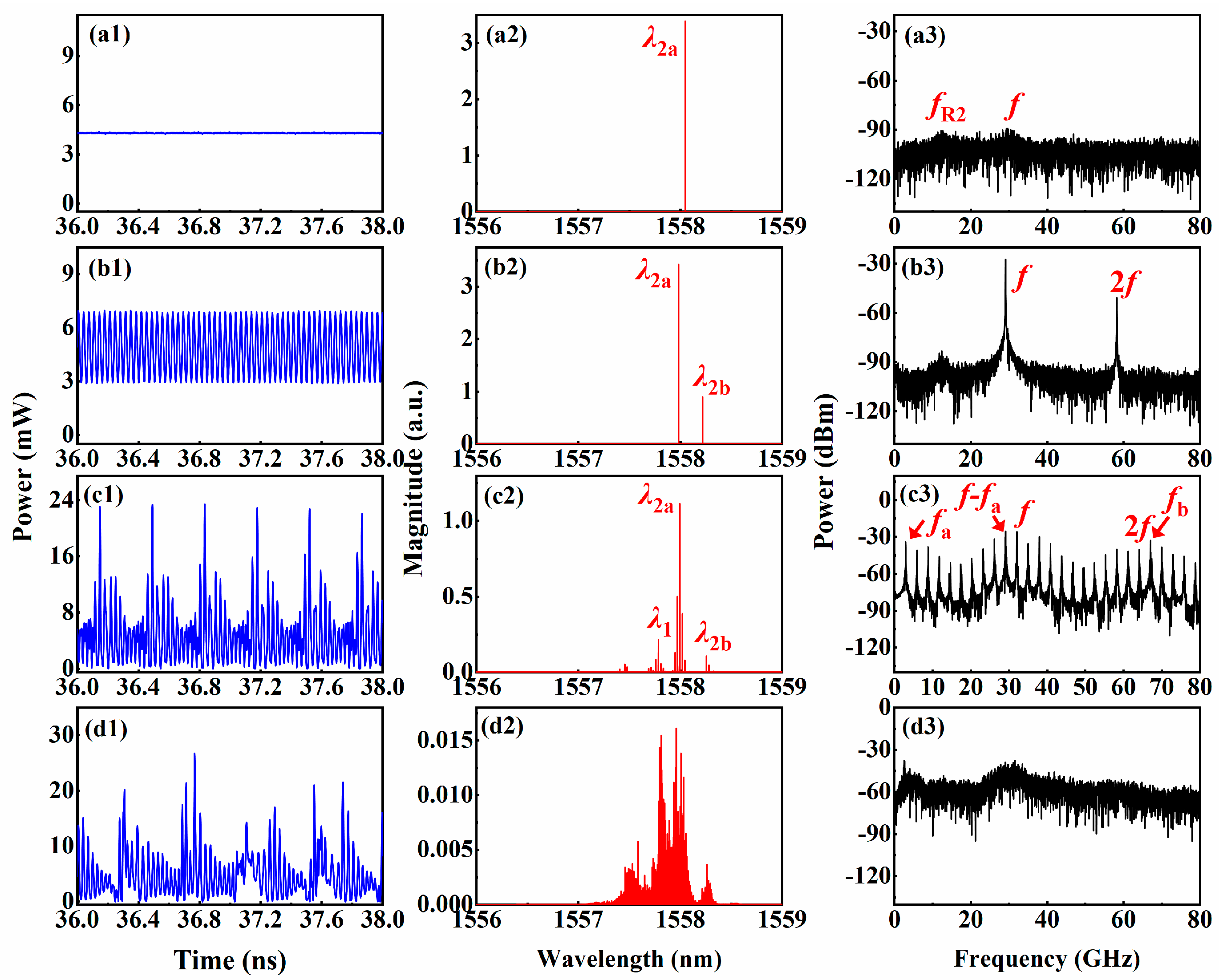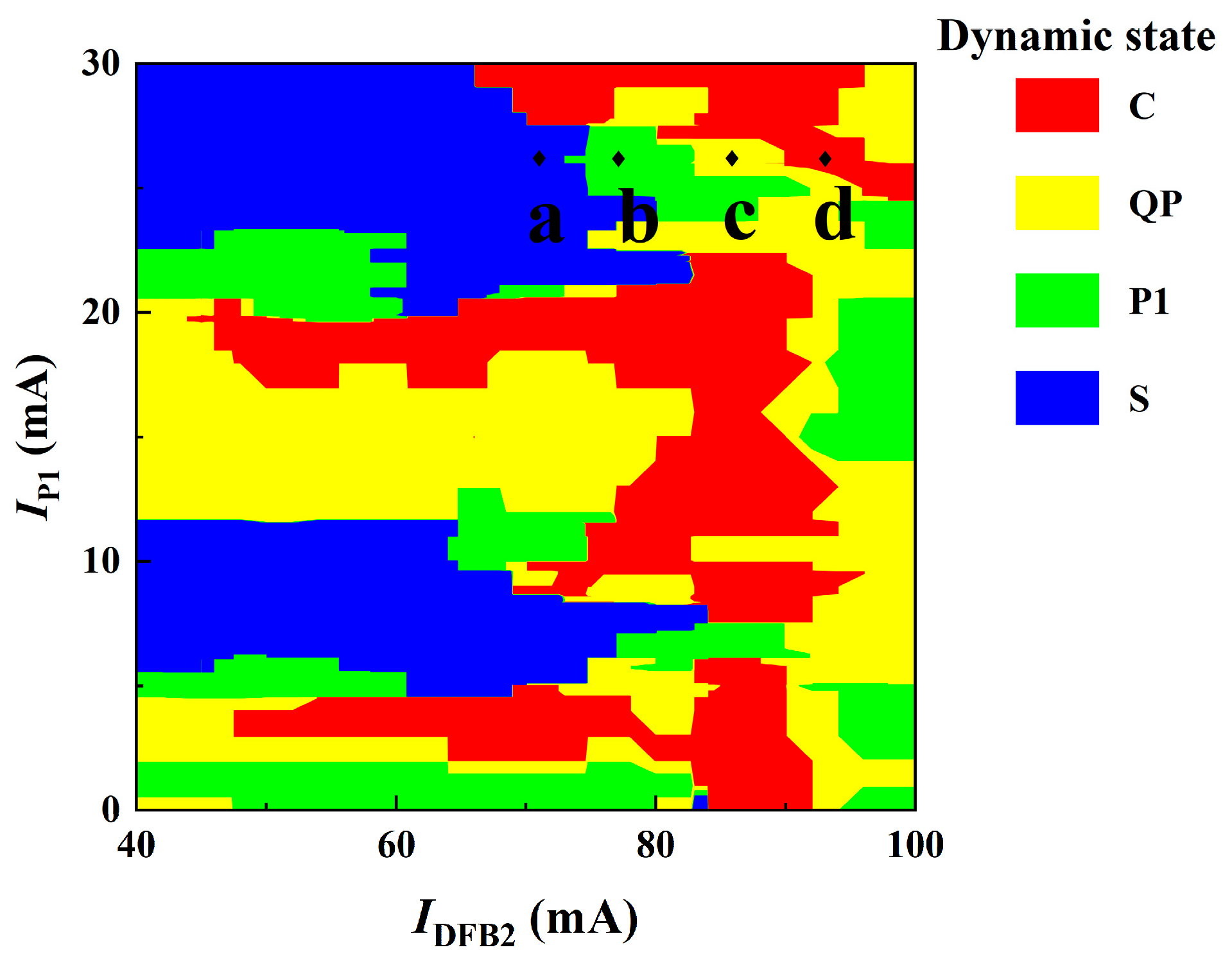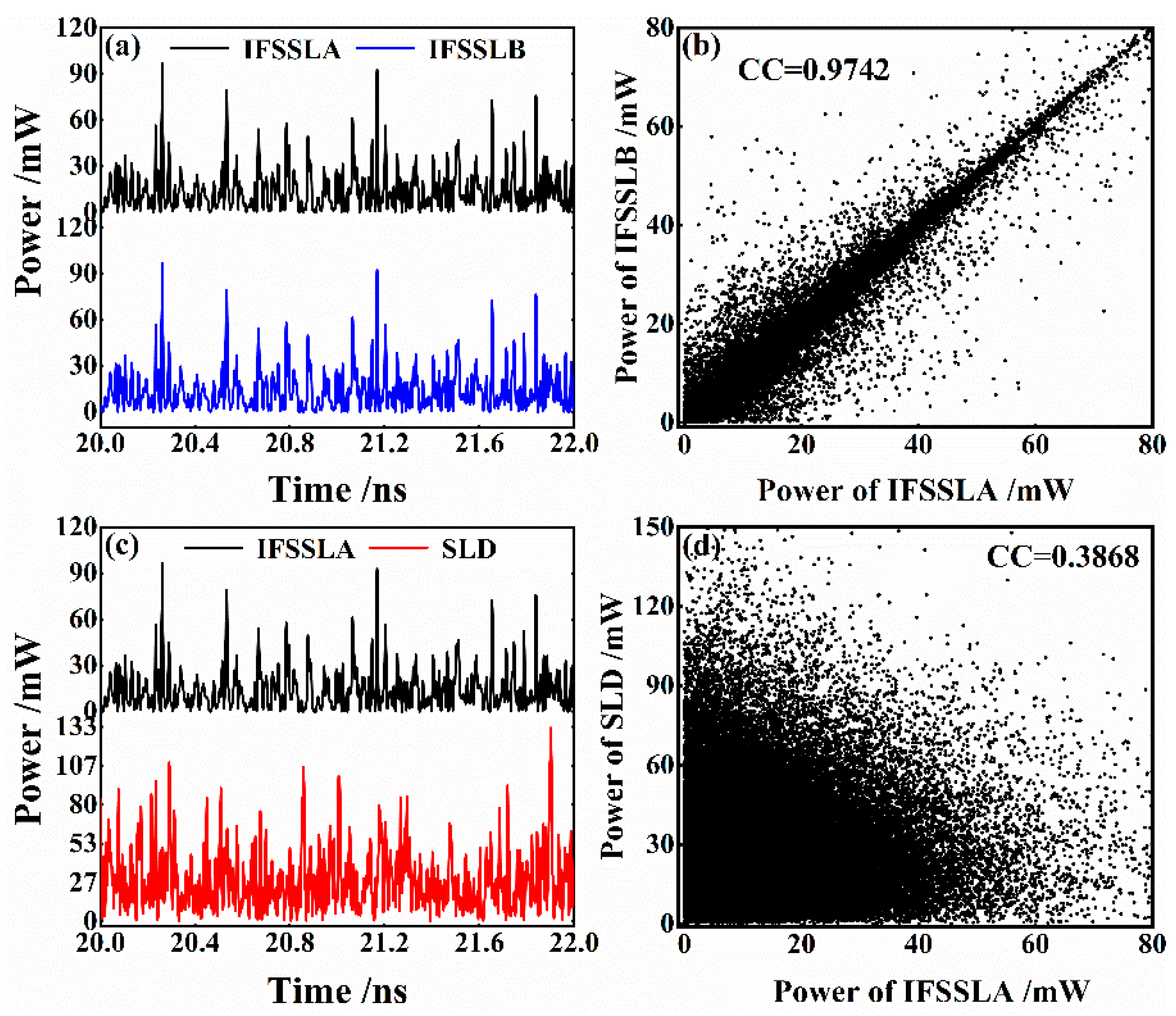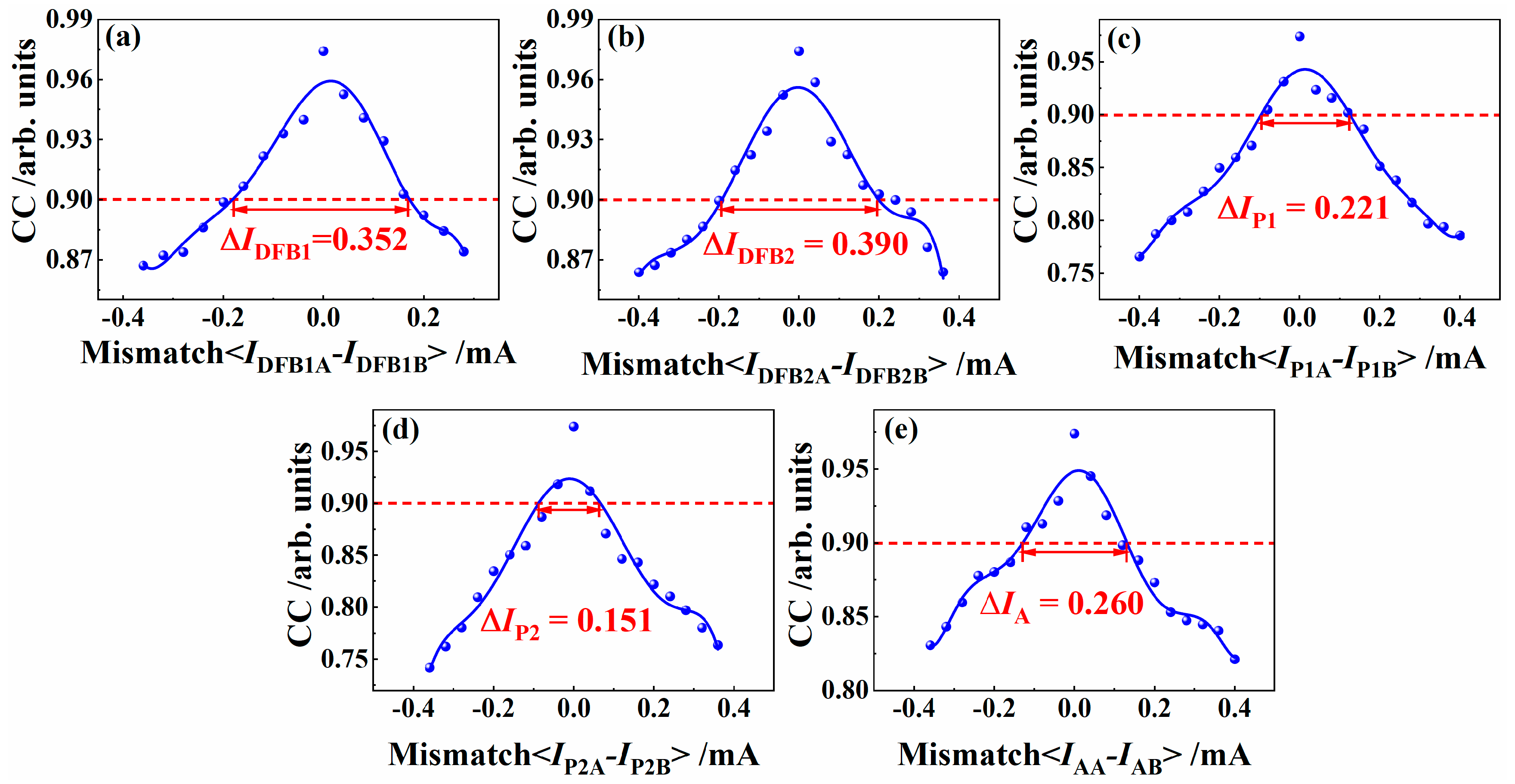Chaos Synchronization of Integrated Five-Section Semiconductor Lasers
Abstract
:1. Introduction
2. Materials and Methods
3. Results
3.1. Dynamic Characterization of IFSSL
3.2. Chaos Synchronization of IFSSL
4. Discussion
5. Conclusions
Author Contributions
Funding
Data Availability Statement
Conflicts of Interest
References
- Fu, Y.; Cheng, M.; Jiang, X.; Yu, Q.; Huang, L.; Deng, L.; Liu, D. High-speed optical secure communication with an external noise source and an internal time-delayed feedback loop. Photonics Res. 2019, 7, 1306–1313. [Google Scholar] [CrossRef]
- Ke, J.; Yi, L.; Xia, G.; Hu, W. Chaotic optical communications over 100-km fiber transmission at 30-Gb/s bit rate. Opt. Lett. 2018, 43, 1323–1326. [Google Scholar] [CrossRef] [PubMed]
- Ke, J.; Yi, L.; Yang, Z.; Yang, Y.; Zhuge, Q.; Chen, Y.; Hu, W. 32 Gb/s chaotic optical communications by deep-learning-based chaos synchronization. Opt. Lett. 2019, 44, 5776–5779. [Google Scholar] [CrossRef]
- Wang, L.; Mao, X.; Wang, A.; Wang, Y.; Gao, Z.; Li, S.; Yan, L. Scheme of coherent optical chaos communication. Opt. Lett. 2020, 45, 4762–4765. [Google Scholar] [CrossRef]
- Yang, Z.; Yi, L.; Ke, J.; Zhuge, Q.; Yang, Y.; Hu, W. Chaotic optical communication over 1000 km transmission by coherent detection. J. Light. Technol. 2020, 38, 4648–4655. [Google Scholar] [CrossRef]
- Wu, J.G.; Wu, Z.M.; Liu, Y.R.; Fan, L.; Xia, G.Q. Simulation of Bidirectional Long-Distance Chaos Communication Performance in a Novel Fiber-Optic Chaos Synchronization System. J. Light. Technol. 2013, 31, 461–467. [Google Scholar] [CrossRef]
- Argyris, A.; Syvridis, D.; Larger, L.; Annovazzi-Lodi, V.; Colet, P.; Fischer, I.; Garcia-Ojalvo, J.; Mirasso, C.R.; Pesquera, L.; Shore, K.A. Chaos-based communications at high bit rates using commercial fibre-optic links. Nature 2005, 438, 343–346. [Google Scholar] [CrossRef] [PubMed]
- Kanakidis, D.; Bogris, A.; Argyris, A.; Syvridis, D. Numerical investigation of fiber transmission of a chaotic encrypted message using dispersion compensation schemes. J. Light. Technol. 2004, 22, 2256. [Google Scholar] [CrossRef]
- Zhang, J.Z.; Wang, A.B.; Wang, J.F.; Wang, Y.C. Wavelength division multiplexing of chaotic secure and fiber-optic communications. Opt. Express 2009, 17, 6357–6367. [Google Scholar] [CrossRef]
- Argyris, A.; Grivas, E.; Hamacher, M.; Bogris, A.; Syvridis, D. Chaos-on-a-chip secures data transmission in optical fiber links. Opt. Express 2010, 18, 5188–5198. [Google Scholar] [CrossRef] [PubMed]
- Li, Q.; Lu, S.; Bao, Q.; Chen, D.; Hu, M.; Zeng, R.; Yang, G.; Li, S. Simultaneous trilateral communication based on three mutually coupled chaotic semiconductor lasers with optical feedback. Appl. Opt. 2018, 57, 251–257. [Google Scholar] [CrossRef] [PubMed]
- Wang, D.; Wang, L.; Li, P.; Zhao, T.; Wang, A. Bias Current of Semiconductor Laser: An Unsafe Key for Secure Chaos Communication. Photonics 2019, 6, 59. [Google Scholar] [CrossRef]
- Wu, J.G.; Xia, G.Q.; Wu, Z.M. Suppression of time delay signatures of chaotic output in a semiconductor laser with double optical feedback. Opt. Express 2009, 17, 20124–20133. [Google Scholar] [CrossRef]
- Hou, T.; Yi, L.; Yang, X.; Ke, J.; Hu, Y.; Yang, Q.; Zhou, P.; Hu, W. Maximizing the security of chaotic optical communications. Opt. Express 2016, 24, 23439–23449. [Google Scholar] [CrossRef]
- Wang, D.M.; Wang, L.S.; Guo, Y.Y.; Wang, Y.C.; Wang, A.B. Key space enhancement of optical chaos secure communication: Chirped FBG feedback semiconductor laser. Opt. Express 2019, 27, 3065. [Google Scholar] [CrossRef] [PubMed]
- Xue, C.; Jiang, N.; Lv, Y.; Li, G.; Lin, S.; Qiu, K. Security-enhanced chaos communication with time-delay signature suppression and phase encryption. Opt. Lett. 2016, 41, 3690–3693. [Google Scholar] [CrossRef] [PubMed]
- Lu, T.; Wang, H.; Ji, Y. Wideband complex-enhanced bidirectional phase chaotic secure communication with time-delay signature concealment. Chaos 2020, 30, 093138. [Google Scholar] [CrossRef] [PubMed]
- Bauer, S.; Brox, O.; Kreissl, J.; Sartorius, B.; Radziunas, M.; Sieber, J.; Wünsche, H.J.; Henneberger, F. Nonlinear dynamics of semiconductor lasers with active optical feedback. Phys. Rev. E 2004, 69, 016206. [Google Scholar] [CrossRef] [PubMed]
- Mohrle, M.; Sartorius, B.; Bornholdt, C.; Bauer, S.; Brox, O.; Sigmund, A.; Steingruber, R.; Radziunas, H.; Wunsche, H.J. Detuned grating multisection-RW-DFB lasers for high-speed optical signal processing. IEEE J. Sel. Top. Quantum Electron. 2001, 7, 217–223. [Google Scholar] [CrossRef]
- Morthier, G.; Schatz, R.; Kjebon, O. Extended modulation bandwidth of DBR and external cavity lasers by utilizing a cavity resonance for equalization. IEEE J. Quantum Electron. 2000, 36, 1468–1475. [Google Scholar] [CrossRef]







| Parameter | Description | Value |
|---|---|---|
| LDFB1 | DFB1 section length | 200 μm |
| LP1 | P1 section length | 400 μm |
| LDFB2 | DFB2 section length | 200 μm |
| LP2 | P2 section length | 400 μm |
| LA | A section length | 320 μm |
| WA | Active region width | 2.50 μm |
| aI | Internal loss factor | 1000 m−1 |
| α | Linewidth enhancement factor | 4 |
| Ci | Index grating coupling coefficient | 15,500 m−1 |
| Cg | Gain grating coupling coefficient | 2000 m−1 |
| N0 | Transparency carrier density | 1.40 × 1024 m−3 |
| Gnon | Nonlinear gain coefficient | 1.00 × 10−23 m3 |
| Gm | Linear material gain coefficient | 3.00 × 10−20 m2 |
| CMQW | Confinement factor MQW | 0.07 |
| Λg | Group index | 3.70 |
Disclaimer/Publisher’s Note: The statements, opinions and data contained in all publications are solely those of the individual author(s) and contributor(s) and not of MDPI and/or the editor(s). MDPI and/or the editor(s) disclaim responsibility for any injury to people or property resulting from any ideas, methods, instructions or products referred to in the content. |
© 2024 by the authors. Licensee MDPI, Basel, Switzerland. This article is an open access article distributed under the terms and conditions of the Creative Commons Attribution (CC BY) license (https://creativecommons.org/licenses/by/4.0/).
Share and Cite
Guo, Y.; Du, Y.; Gao, H.; Tan, M.; Zhao, T.; Jia, Z.; Chang, P.; Wang, L. Chaos Synchronization of Integrated Five-Section Semiconductor Lasers. Entropy 2024, 26, 405. https://doi.org/10.3390/e26050405
Guo Y, Du Y, Gao H, Tan M, Zhao T, Jia Z, Chang P, Wang L. Chaos Synchronization of Integrated Five-Section Semiconductor Lasers. Entropy. 2024; 26(5):405. https://doi.org/10.3390/e26050405
Chicago/Turabian StyleGuo, Yuanyuan, Yao Du, Hua Gao, Min Tan, Tong Zhao, Zhiwei Jia, Pengfa Chang, and Longsheng Wang. 2024. "Chaos Synchronization of Integrated Five-Section Semiconductor Lasers" Entropy 26, no. 5: 405. https://doi.org/10.3390/e26050405






